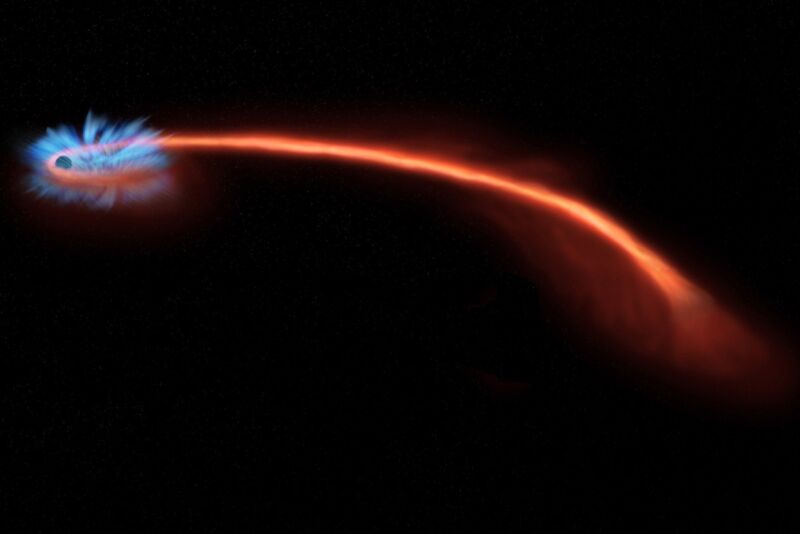

Polarized light reveals final fate of a star “spaghettified” by a black hole
source link: https://arstechnica.com/science/2022/07/polarized-light-reveals-final-fate-of-a-star-spaghettified-by-a-black-hole/
Go to the source link to view the article. You can view the picture content, updated content and better typesetting reading experience. If the link is broken, please click the button below to view the snapshot at that time.

Rip it to shreds —
Polarized light reveals final fate of a star “spaghettified” by a black hole
It's “the first time anyone has deduced the shape of the gas cloud around a spaghettified star.”
Jennifer Ouellette - 7/13/2022, 3:00 PM

When astronomers first observed a star that was shredded, or “spaghettified,” after approaching too close to a massive black hole in 2019, they determined that much of the star’s matter was launched outward in a powerful wind from the optical light emitted from the blast. Now, astronomers from the University of California, Berkeley (UCB) have analyzed the polarization of that light to determine that the cloud was likely spherically symmetric, adding further evidence for the presence of that powerful wind.
“This is the first time anyone has deduced the shape of the gas cloud around a tidally spaghettified star,” said co-author Alex Filippenko, a UCB astronomer. The latest findings appeared in a recent paper published in the Monthly Notices of the Royal Astronomical Society.
As we've reported previously, an object that passes beyond the event horizon of a black hole—including light—is swallowed up and can't escape, although black holes are also messy eaters. That means that part of an object's matter is actually ejected in a powerful jet. If that object is a star, the process of being shredded (or "spaghettified") by the powerful gravitational forces of a black hole occurs outside the event horizon, and part of the star's original mass is ejected violently outward. This can form a rotating ring of matter (aka, an accretion disk) around the black hole that emits powerful X-rays and visible light. The jets are one way astronomers can indirectly infer the presence of a black hole.In 2018, astronomers announced the first direct image of the aftermath of a star being shredded by a black hole 20 million times more massive than our Sun in a pair of colliding galaxies called Arp 299 about 150 million-light-years from Earth. A year later, astronomers recorded the final death throes of a star being shredded by a supermassive black hole in just such a "tidal disruption event" (TDE), dubbed AT 2019qiz. The star was torn apart with about half of its mass feeding—or accreting—into a black hole of 1 million times the mass of the Sun, and the other half was ejected outward.
These powerful bursts of light are often shrouded behind a curtain of interstellar dust and debris, making it difficult for astronomers to study them in greater detail. But AT 2019qiz was discovered shortly after the star had been shredded last year, making it easier to study in detail, before that curtain of dust and debris had fully formed. Astronomers conducted follow-up observations across the electromagnetic spectrum over the next six months, using multiple telescopes around the world. Those observations provided the first direct evidence that outflowing gas during disruption and accretion produces the powerful optical and radio emissions previously observed.
AdvertisementAstronomers knew that the emitted optical light had a slight 1 percent polarization based on observations from the 3-meter Shane telescope at Lick Observatory near San Jose, California; the observatory includes a spectrograph to determine the polarization of optical light. The light would have become polarized after scattering off electrons in the gas cloud. Given how distant such TDEs tend to be, they usually appear as only a point of light, and polarization is one of a handful of properties hinting at the shapes of objects.
According to co-author Kishore Patra, much of the light emitted from the accretion disk would have started out in the X-ray regime, but as it passed through the gas cloud, that light kept losing energy thanks to various scattering, absorptions, and reemissions, eventually emerging in the optical regime. "The final scatter then determines the polarization state of the photon," said Patra. "So, by measuring polarization, we can deduce the geometry of the surface where the final scatter happens.”
Based on the October 2019 polarization measurements showing zero polarization, the Berkeley scientists calculated that the light came from a spherical cloud with a surface radius of about 100 astronomical units (au), or about 100 times larger than the Earth's orbit. However, measurements taken a month later revealed a 1 percent polarization of the light, suggesting that the cloud had thinned and taken on a slight asymmetry.
“This observation rules out a class of solutions that have been proposed theoretically and gives us a stronger constraint on what happens to gas around a black hole,” said Patra. “People have been seeing other evidence of wind coming out of these events, and I think this polarization study definitely makes that evidence stronger, in the sense that you wouldn't get a spherical geometry without having a sufficient amount of wind. The interesting fact here is that a significant fraction of the material in the star that is spiraling inward doesn't eventually fall into the black hole—it's blown away from the black hole.”
DOI: Monthly Notices of the Royal Astronomical Society, 2022. 10.1093/mnras/stac1727 (About DOIs).
Recommend
About Joyk
Aggregate valuable and interesting links.
Joyk means Joy of geeK
